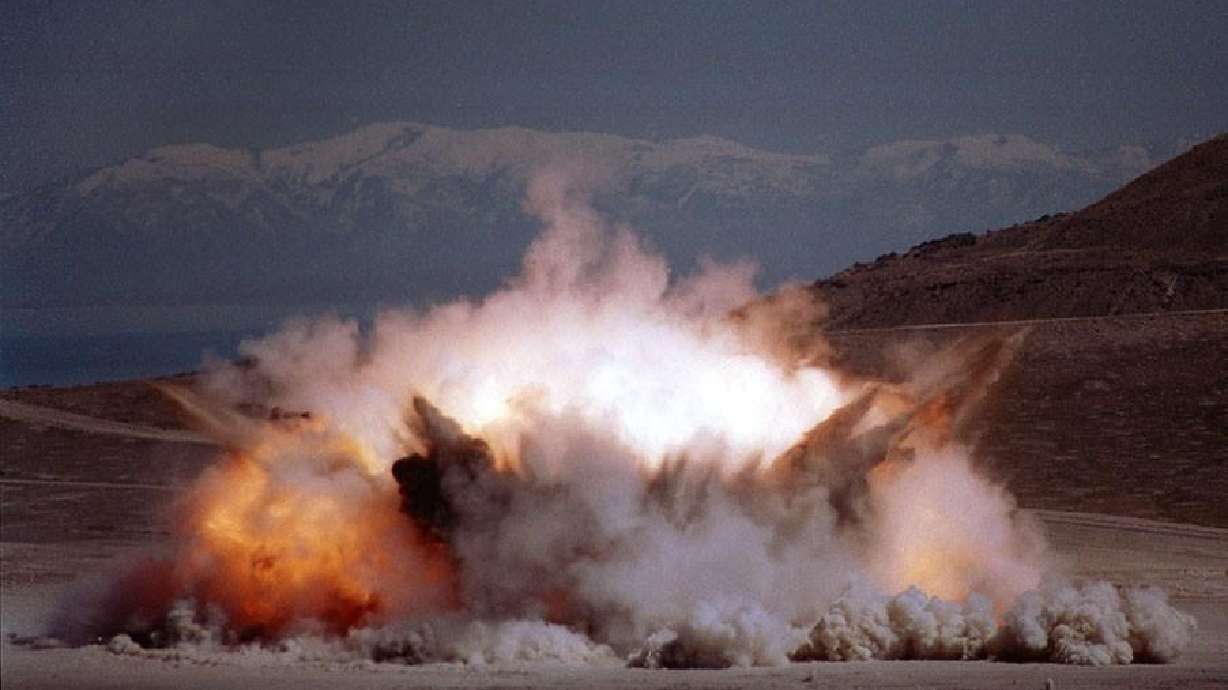Estimated read time: 3-4 minutes
This archived news story is available only for your personal, non-commercial use. Information in the story may be outdated or superseded by additional information. Reading or replaying the story in its archived form does not constitute a republication of the story.
OGDEN — Hill Air Force Base has announced it is blowing up old rocket motors in Utah's remote west desert, as part of an ongoing project that has been disposing of munitions for 30 years.
The Utah Test and Training Range is the only location in the United States where detonations of this scale are allowed — more than 10,000 pounds of net explosive weight, according to Hill Air Force Base. One or two explosions a week are expected through September, though weather and changing workload may alter the schedule.
These detonations happen at the Thermal Treatment Unit, described in a Department of Environmental Quality report as a 2-square-mile area in a gently southwestward-sloping valley adjacent to the western shore of the Great Salt Lake in Box Elder County.
The site has been operating for more than three decades, "treating" munitions and their components in open burn and open detonation pads, according to the report. It is used for decommissioning dangerous objects like mines, grenades, mortar rounds, torpedos, guided and ballistic missiles and rockets, among others.
To date, the Air Force has safely detonated more than a million pounds of missile motor propellant, according to its website.
Environmental impact of blasts
Since 2012, more than 300 old or obsolete Department of Defense motors have been disposed of in this way. Amanda Burton, 75th Civil Engineer Group's environmental branch chief, said in a Hill AFB statement that detonation is environmentally the best current way to dispose of these large rocket motors.
In January 2023, a contractor performed a study of soil data on the site, finding no "significant potential for site-related ecological risks" to the mammals like coyotes and pronghorn antelope, and surrounding vegetation.
The explosion itself converts nearly all the carbon in the explosive mixtures to CO2. A Department of Environmental Quality ecological impact report found all detected emissions were at "very low levels, typically at the parts per trillion."
The report also outlines the two types of waste generated from the explosion — solid waste like large metal scraps or pyrotechnic material, and ash which has "a potential for toxicity." Sampling after the blasts determines whether that ash is transported to a hazardous waste disposal facility, or if it will be treated as solid waste and transported to a disposal site along with the remains of whatever munition was blown to bits.
Will we hear it?
The scale of these explosions is so large that there is concern those along the Wasatch Front will hear, and feel, the resulting impulses.
"We want to do this work without adversely affecting our neighbors and the environment," Burton said in the statement.
Before every detonation, a spokesman for Hill said the operators will take weather measurements and input the data into a sound prediction model. If wind is blowing toward the heavily populated areas 80 miles east, for example, the detonation may be felt or heard. If the model predicts that sound is going to be louder than permitted levels at locations along the Wasatch Front, the detonations are delayed, according to the statement.
But the accuracy of the Air Force's sound prediction model is not perfect.
"Atmospheric conditions can change rapidly between the time we take a reading and the actual detonation," Burton said. "This current model we're using is a very reliable tool in determining how far sound from a detonation will travel from the UTTR."










